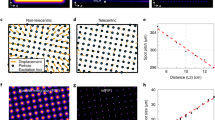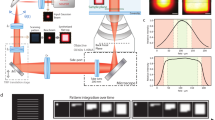Abstract
Biological processes are inherently multi-scale, and supramolecular complexes at the nanoscale determine changes at the cellular scale and beyond. Single-molecule localization microscopy (SMLM)1,2,3 techniques have been established as important tools for studying cellular features with resolutions of the order of around 10 nm. However, in their current form these modalities are limited by a highly constrained field of view (FOV) and field-dependent image resolution. Here, we develop a low-cost microlens array (MLA)-based epi-illumination system—flat illumination for field-independent imaging (FIFI)—that can efficiently and homogeneously perform simultaneous imaging of multiple cells with nanoscale resolution. The optical principle of FIFI, which is an extension of the Köhler integrator, is further elucidated and modelled with a new, free simulation package. We demonstrate FIFI's capabilities by imaging multiple COS-7 and bacteria cells in 100 × 100 μm2 SMLM images—more than quadrupling the size of a typical FOV and producing near-gigapixel-sized images of uniformly high quality.
This is a preview of subscription content, access via your institution
Access options
Subscribe to this journal
Receive 12 print issues and online access
$209.00 per year
only $17.42 per issue
Buy this article
- Purchase on Springer Link
- Instant access to full article PDF
Prices may be subject to local taxes which are calculated during checkout




Similar content being viewed by others
References
Rust, M. J., Bates, M. & Zhuang, X. Sub-diffraction-limit imaging by stochastic optical reconstruction microscopy (STORM). Nat. Methods 3, 793–795 (2006).
Betzig, E. et al. Imaging intracellular fluorescent proteins at nanometer resolution. Science 313, 1642–1645 (2006).
Hess, S. T., Girirajan, T. P. K. & Mason, M. D. Ultra-high resolution imaging by fluorescence photoactivation localization microscopy. Biophys. J. 91, 4258–4272 (2006).
Gustafsson, M. G. L. Surpassing the lateral resolution limit by a factor of two using structured illumination microscopy. J. Microsc. 198, 82–87 (2000).
Heintzmann, R. & Cremer, C. G. Laterally modulated excitation microscopy: improvement of resolution by using a diffraction grating. Proc. SPIE 3568, 185–196 (1999).
Hell, S. W. & Wichmann, J. Breaking the diffraction resolution limit by stimulated emission: stimulated-emission-depletion fluorescence microscopy. Opt. Lett. 19, 780–782 (1994).
Schwentker, M. A. et al. Wide-field subdiffraction RESOLFT microscopy using fluorescent protein photoswitching. Microsc. Res. Tech. 70, 269–280 (2007).
Chmyrov, A. et al. Nanoscopy with more than 100,000 ‘doughnuts’. Nat. Methods 10, 737–740 (2013).
Nieuwenhuizen, R. P. J. et al. Measuring image resolution in optical nanoscopy. Nat. Methods 10, 557–562 (2013).
Heilemann, M. et al. Subdiffraction-resolution fluorescence imaging with conventional fluorescent probes. Angew. Chem. Int. Ed. Engl. 47, 6172–6176 (2008).
Burgert, A., Letschert, S., Doose, S. & Sauer, M. Artifacts in single-molecule localization microscopy. Histochem. Cell Biol. 144, 123–131 (2015).
van de Linde, S. et al. Direct stochastic optical reconstruction microscopy with standard fluorescent probes. Nat. Protoc. 6, 991–1009 (2011).
Huang, F. et al. Video-rate nanoscopy using sCMOS camera-specific single-molecule localization algorithms. Nat. Methods 10, 653–658 (2013).
Völkel, R. & Weible, K. J. Laser beam homogenizing: limitations and constraints. Proc. SPIE 7102, 71020J–71020J-12 (2008).
Büttner, A. & Zeitner, U. D. Wave optical analysis of light-emitting diode beam shaping using microlens arrays. Opt. Eng. 41, 2393–2401 (2002).
Brown, D. M., Dickey, F. M. & Weichman, L. S. in Laser Beam Shaping: Theory and Techniques (eds Dickey, F. M. & Holswade, S. C.) Ch. 7 (CRC Press, 2000).
Streibl, N., Nölscher, U., Jahns, J. & Walker, S. Array generation with lenslet arrays. Appl. Opt. 30, 2739–2742 (1991).
Scholtens, T. M. et al. Celltracks TDI: an image cytometer for cell characterization. Cytom. Pt A 79A, 203–213 (2011).
Model, M. A. & Blank, J. L. Concentrated dyes as a source of two-dimensional fluorescent field for characterization of a confocal microscope. J. Microsc. 229, 12–16 (2008).
Lin, Y. et al. Quantifying and optimizing single-molecule switching nanoscopy at high speeds. PLoS ONE 10, e0128135 (2015).
Schlimpert, S. et al. General protein diffusion barriers create compartments within bacterial cells. Cell 151, 1270–1282 (2012).
Almada, P., Culley, S. & Henriques, R. PALM and STORM: into large fields and high-throughput microscopy with sCMOS detectors. Methods 88, 109–121 (2015).
Huang, Z.-L. et al. Localization-based super-resolution microscopy with an sCMOS camera. Opt. Express 19, 19156–19168 (2011).
Bates, M., Dempsey, G. T., Chen, K. H. & Zhuang, X. Multicolor super-resolution fluorescence imaging via multi-parameter fluorophore detection. ChemPhysChem 13, 99–107 (2012).
Venkataramani, V., Herrmannsdörfer, F., Heilemann, M. & Kuner, T. Suresim: simulating localization microscopy experiments from ground truth models. Nat. Methods 13, 319–321 (2016).
Ovesný, M., Křížek, P., Borkovec, J., Svindrych, Z. & Hagen, G. M. ThunderSTORM: a comprehensive ImageJ plug-in for PALM and STORM data analysis and super-resolution imaging. Bioinformatics 30, 2389–2390 (2014).
Voelz, D. G. Computational Fourier Optics: A MATLAB Tutorial (SPIE, 2011); http://spie.org/Publications/Book/858456.
Xiao, X. & Voelz, D. Wave optics simulation approach for partial spatially coherent beams. Opt. Express 14, 6986–6992 (2006).
Edelstein, A. D. et al. Advanced methods of microscope control using μManager software. J. Biol. Methods 1, e10 (2014).
Olivier, N., Keller, D., Gönczy, P. & Manley, S. Resolution doubling in 3D-STORM imaging through improved buffers. PLoS ONE 8, e69004 (2013).
Acknowledgements
The authors would like to thank K. Bellvé for providing the pgFocus hardware, F. Huang for his help in troubleshooting the sCMOS localization software, D. G. Voelz for providing code examples for modelling partially coherent optical fields, R. Völkel for discussions about the Köhler integrator and N. Berliner, D. Ott, M. Weidman and P. Ramdya for useful discussions. Research in S.M.'s laboratory is supported by the National Centre of Competence in Research Chemical Biology and by the European Research Council (ERC 243016-PALMassembly). K.M.D. is supported by a SystemsX.ch Transition Postdoc Fellowship (2014/227).
Author information
Authors and Affiliations
Contributions
S.M. and K.M.D. conceived the idea. K.M.D. designed the epi-illumination system, built the microscope and wrote the simulation code. C.S. and A.L. performed the cell preparation and imaging. C.S. and A.A. assisted K.M.D. with building and testing the microscope. K.M.D. wrote the manuscript with contributions from all authors.
Corresponding authors
Ethics declarations
Competing interests
The authors declare no competing financial interests.
Supplementary information
Supplementary information
Supplementary information (PDF 4064 kb)
Rights and permissions
About this article
Cite this article
Douglass, K., Sieben, C., Archetti, A. et al. Super-resolution imaging of multiple cells by optimized flat-field epi-illumination. Nature Photon 10, 705–708 (2016). https://doi.org/10.1038/nphoton.2016.200
Received:
Accepted:
Published:
Issue Date:
DOI: https://doi.org/10.1038/nphoton.2016.200
This article is cited by
-
Field-dependent deep learning enables high-throughput whole-cell 3D super-resolution imaging
Nature Methods (2023)
-
Mold-free self-assembled scalable microlens arrays with ultrasmooth surface and record-high resolution
Light: Science & Applications (2023)
-
Maximum-likelihood model fitting for quantitative analysis of SMLM data
Nature Methods (2023)
-
Single-molecule localization microscopy
Nature Reviews Methods Primers (2021)
-
Fast widefield scan provides tunable and uniform illumination optimizing super-resolution microscopy on large fields
Nature Communications (2021)



